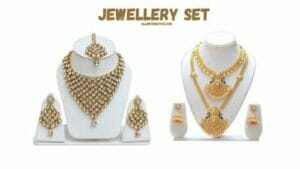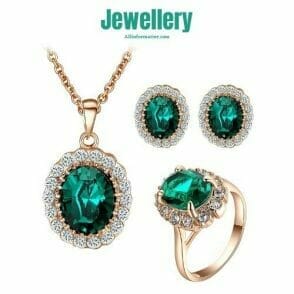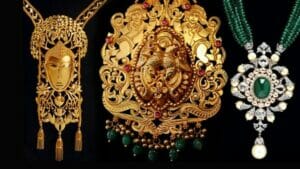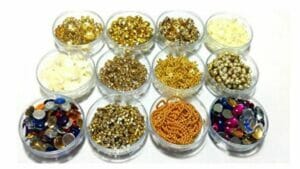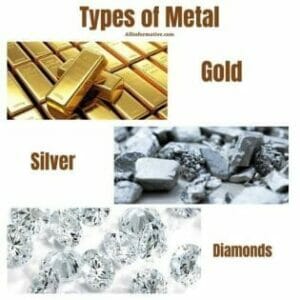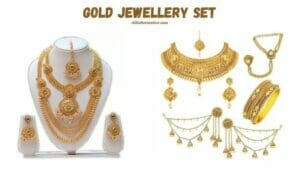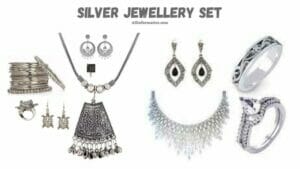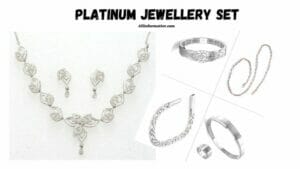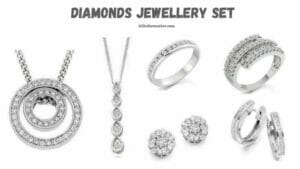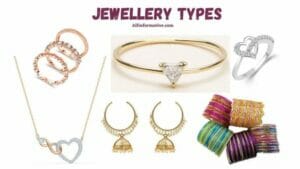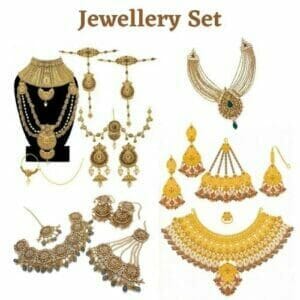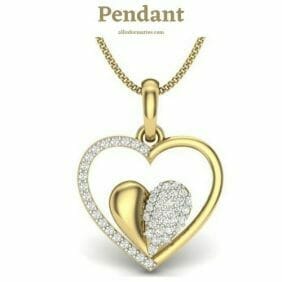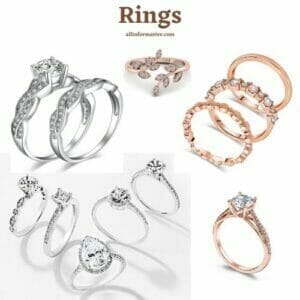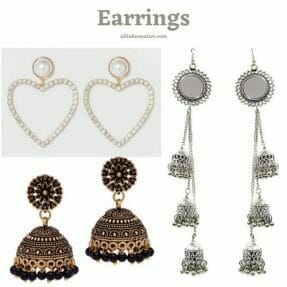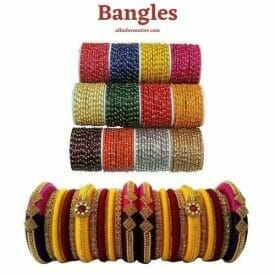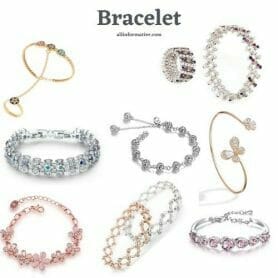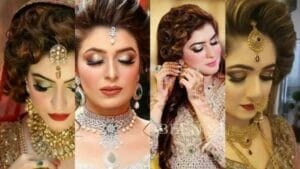The word Jewellery itself is derive from the word jewel. It was anglicise from Old French “Jouel” and beyond that to the Latin word “Jocale” meaning plaything. Both used in Canadian English, though jewellery prevails by two to one margin. In this page we talk about Jewellery Set | Best Jewellry Set Designs Ideas and Price.
Contents
Jewellery:
Jewellery or jewelry consists of decorative items worn for personal adornment. Such as brooches, rings, necklaces, earrings, pendants, bracelets and cufflinks. Jewellery may be attached to body or clothes. From a western perspective, term restricted to durable ornaments, excluding flowers for example. Jewellery may be made from wide range of materials.
Jewellery is one of oldest types of archaeological artefact with 100,000 year old beads made from Nassarius shells thought to be oldest known jewellery. For many centuries metal such as gold use in different carats from 21, 18, 12, 9 or even lower. Often combine with gemstones has been normal material for jewellery. But other materials such as shells and other plant materials may be used.
The basic forms of jewellery vary between cultures but are often extremely long lived. In European cultures the most common forms of jewellery listed above have persisted since ancient times. While other forms such as adornments for nose or ankle. Thats important in other cultures are much less common.
Gemstones and similar materials such as amber and coral, precious metals, beads and shells have been widely use and enamel has often been important. In most cultures jewellery can be understood as status symbol for its material properties, its patterns or for meaningful symbols. Jewellery has been made to adorn nearly every body part from hairpins to toe rings and even genital jewellery. In modern European culture amount worn by adult males is relatively low compare with other cultures and other periods in European culture.
History:
The history of jewellery is long and goes back many years, with many different uses among different cultures. It has endured for thousands of years and has provided various insights into how ancient cultures worked. Many items of jewellery, such as brooches and buckles, originated as purely functional items, but evolved into decorative items as their functional requirement diminished.
The word jewellery itself is derive from the word jewel. That anglicised from Old French “jouel” and beyond that to the Latin word “jocale” meaning plaything. In British English, Indian English, New Zealand English, Hiberno-English, Australian English and South African English it is spelled jewellery.
While spelling is jewelry in American English. Both are use in Canadian English, though jewelry prevails by two to one margin. In French and few other European languages equivalent term, joaillerie. It may also cover decorated metalwork in precious metal. Such as objets d’art and church items, not just objects worn on person. Jewelry is often use in medical field for health related purposes and patient care.
The earliest known Jewellery was actually create not by humans but by Neanderthal living in Europe. Specifically, perforated beads made from small sea shells. It have been found dating to 115,000 years ago in Cueva de los Aviones, cave along southeast coast of Spain. Later in Kenya at Enkapune Ya Muto, beads made from perforated ostrich egg shells have been dated to more than 40,000 years ago. In Russia, stone bracelet and marble ring are attributed to similar age.
Materials And Methods:
The first materials used to make objects for personal adornment were taken from animal and vegetable world. The material taken from animal world in natural or processed form. It constituted the actual adornment whereas vegetable fibres served as its support. A great variety of shells and pieces of shell were use during prehistoric age.
These still use in certain island and coastal cultures to make necklaces, bracelets, pendants, and headdresses. In inland regions first materials used for personal adornment came from mammoths tusks, horns of reindeer and other animals and later on, amber and lignite.
Another rare metal, whose use in jewelry is fairly recent is platinum. From 19th century onward this metal was use ever more frequently in jewelry because of its white brilliance and malleability. As well as its resistance to acids and its high melting point. The Jewellery Set also available in Platinum Metal.
Diamonds:
Diamonds were first mined in India. Pliny may have mention them, although there is some debate as to exact nature of the stone he referred to as Adamas. In 2005, Australia, Botswana, Russia and Canada rank among primary sources of gemstone diamond production. The Jewellery Set also available in Diamonds.
There are negative consequences of diamond trade in certain areas. Diamonds mined during recent civil wars in Angola, Ivory Coast, Sierra Leone and other nations. They have been label as blood diamonds when they are mined in war zone and sold to finance an insurgency. The British crown jewels contain Cullinan Diamond, part of largest gem quality rough diamond ever found, 1905 at 3,106.75 carats or 621.35 g.
Now popular in engagement rings, this usage dates back to marriage of Maximilian I to Mary of Burgundy in 1477. A popular style is diamond solitaire which features single large diamond mounted prominently. Within solitaire, there are 3 categories in which a ring can be classified into prong, bezel and tension setting.
Jewellery Types:
Jewellery is a unique product category, which elicits strong emotions from potential buyers. If you’re selling jewellery online, your product descriptions are where you make the pitch to prospects. Given the emotional and expensive nature of these products, they demand a descriptive writing style that clearly explains the features while highlighting the aesthetic aspects of the piece.
When writing product descriptions for jewellery, it is important to including all essential facts such as size, material content, weight, and anything else that a prospective shopper would need to know. Shoppers may or not want to contact you via email or telephone to know the details of product. So to close the sale, ensure you provide answers to all possible queries in the description itself.
Jewellery Set:
Humans used jewellery for a number of different reasons: functional, generally to fix clothing or hair in place. As marker of social status and personal status as with wedding ring. as signifier of some form of affiliation whether ethnic, religious or social.
A necklace is jewelry you wear around your neck. A necklace can be simple gold or silver chain, length of beads or gems or a pendant hanging from cord. As long as it’s worn around the neck, it is a necklace. The word which dates from late 1500s, combines neck with lace. Its meaning “cord” from Old French laz, string, cord or snare. The Latin root, laqueum, means “noose or snare”.
Pendant:
A pendant is a loose hanging piece of jewellery, generally attach by small loop to a necklace. It may be known as “pendant necklace”. A pendant earring is an earring with a piece hanging down. Its name stems from Latin word “pendere” and Old French word “pendr” both of which translate to “to hang down”.
The part of pendant that goes over chain is called bail or bale. Most bails attached to metal pendant. Pendant in jewelry, ornament suspend from a bracelet, earring or especially, necklace. Pendants are derive from primitive practice of wearing amulets or talismans around neck.
Rings:
A ring is a round band, usually of metal, worn as ornamental jewellery. Rings always fit snugly around or in part of the body they ornament, so bands worn loosely like bracelet, are not rings. Rings may be made of almost any hard material; wood, bone, stone, metal, glass, gemstone or plastic.
The term “ring” by itself always denotes jewellery worn on the finger. When worn as an ornament elsewhere, body part is specified within term, e.g., earrings, neck rings, arm rings and toe rings. Rings and other types of jewelry including necklaces, rings, bracelets, earrings, bangles and pendants have been discover from 3rd millennium BC Indus Valley Civilization.
Earrings:
An Earring is jewelry you wear on your ear. Your favorite earrings might be tiny white pearls or they might be long feathers that dangle to your shoulders. An earring is any kind of ring, stud, hoop or dangling decoration that you clip on your earlobe or hook through hole pierced in your ear.
Earring components made of any number of materials including metal, plastic, glass, precious stone, beads, wood, bone and other materials. Designs range from small loops and studs to large plates and dangling items. The size ultimately limited by physical capacity of earlobe to hold earring without tearing. However, heavy earrings worn over extended periods of time may lead to stretching of earlobe and piercing.
Bangles:
Bangles are traditionally rigid bracelets which are usually made of metal, wood, glass or plastic. These ornaments worn mostly by women from Asia and Africa. It is common to see a new bride wearing glass bangles at her wedding.
Some men and women wear a single bangle on arm or wrist called kada or kara. In Sikhism, father of a Sikh bride will give groom a gold ring, kara that steel or iron bangle, and a mohra. Choora is kind of bangle that wear by Punjabi women on her wedding day. It is set of white and red bangles with stonework. According to tradition, woman is not suppose to buy bangles she will wear.
Bracelet:
A Bracelet is an article of jewellery that wear around the wrist. Bracelets can be manufacture from metal, leather, cloth, plastic, bead or other materials. Jewelry bracelets sometimes contain jewels, rocks, wood, shells, crystals, metal or plastic hoops, pearls and many more materials.
If a bracelet is a single, inflexible loop, it often called a bangle. When it is worn around the ankle it is called an ankle bracelet or anklet. A boot bracelet is use to decorate boots. Colloquially, handcuffs sometimes called bracelets. Bracelets may worn to signify certain phenomenon such as breast cancer awareness, or for religious and cultural purposes.
Modern Jewellery Set:
Most modern commercial jewellery Set continues traditional forms and styles. Designers such as Georg Jensen widened concept of wearable art. The advent of new materials such as plastics, Precious Metal Clay, and colouring techniques. It has led to increase variety in styles. Other advances such as development of improve pearl harvesting by people. Also such as Mikimoto Kōkichi and development of improve quality artificial gemstones such as moissanite.
The “jewellery as art” movement spearheaded by artisans such as Robert Lee Morris. It continued by designers such as Gill Forsbrook in UK. Influence from other cultural forms is also evident. One example of this is bling bling style jewellery, popularise by hip hop and rap artists in early 21st century, e.g. grills, type of jewellery worn over teeth.
Artisan jewellery Set continues to grow as both hobby and profession. With more than 17 United States periodicals about beading alone, resources, accessibility and low initial cost of entry continues to expand production of hand made adornments. Some fine examples of artisan jewellery can seen at Metropolitan Museum of Art in New York City. Australia now has thriving contemporary jewellery community.
Many of these jewellers embraced modern materials and techniques. As well as incorporating traditional workmanship. More expansive use of metal to adorn wearer, where piece is larger and more elaborate than what would normally be consider jewellery. It has come to be refer to by designers and fashion writers as metal couture.
Conclusion:
Jewellery or jewelry consists of decorative items worn for personal adornment. Such as brooches, rings, necklaces, earrings, pendants, bracelets and cufflinks. Jewellery attached to body or clothes. The word Jewellery itself is derive from the word jewel. It was anglicise from Old French “Jouel” and beyond that to the Latin word “Jocale” meaning plaything. Both used in Canadian English, though jewellery prevails by two to one margin.
